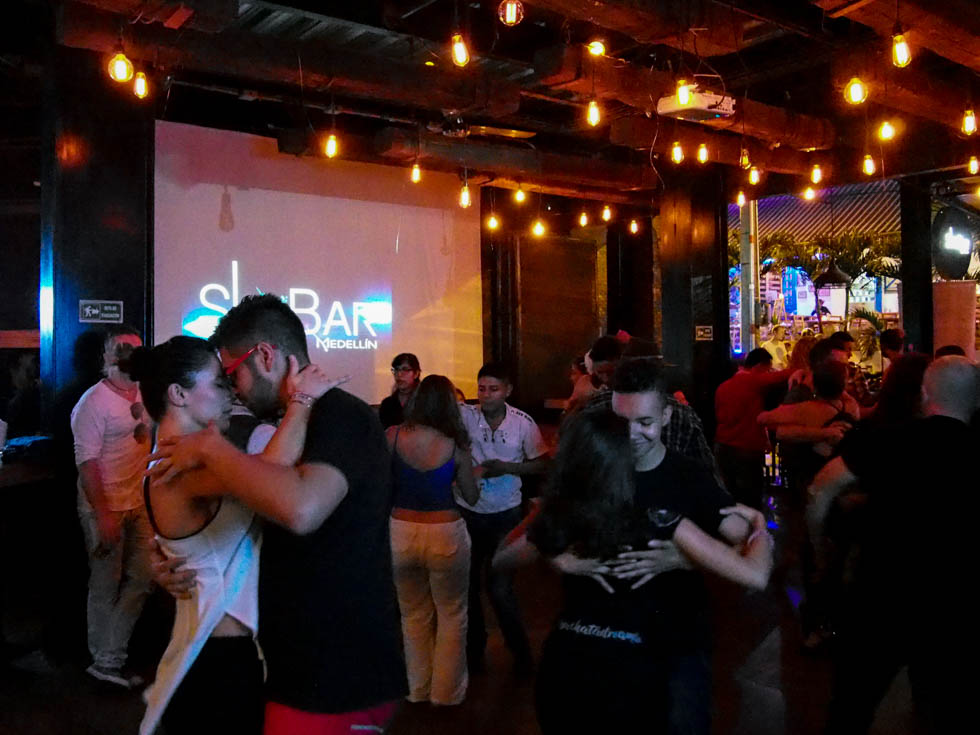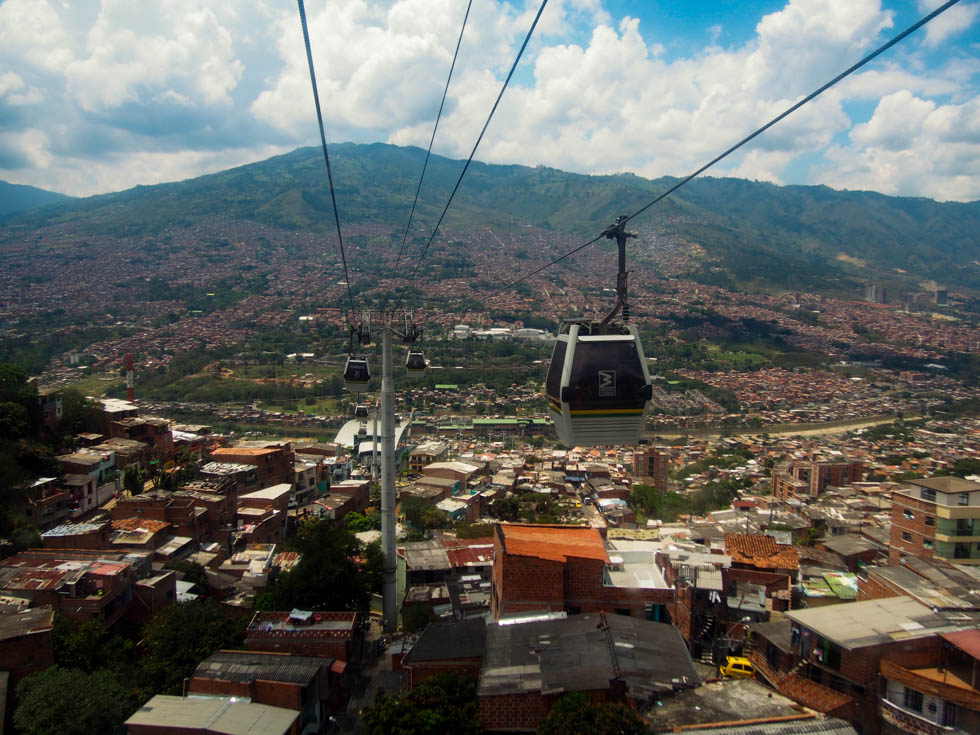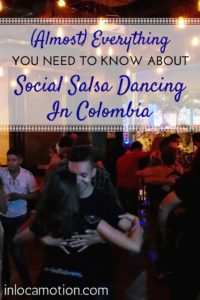
Social dancing in Medellín, Colombia
As a salsa dancer, Colombia beckoned me. How many times had I swayed my hips to Colombian salsa classics such as Cali Pachanguero or Rebelión? Cali is considered one of the salsa dancing capitals of the world, and Colombia a country in which salsa is an integral part of the culture. As a dancer, I had to go.
Naturally, I had very high expectations for dance in Colombia. And from just my first steps in Colombia, I became aware that there was salsa everywhere. I heard salsa music playing from stores, blaring from passing cars, and from the walls of dark clubs throughout the country. It’s pretty great to be strolling around Bogotá and able to sing along to the passing sounds of Una Aventura. What a soundtrack!
But, in spite of the great presence of salsa in Colombia, I didn’t actually dance all that much while there (at least, I didn’t dance that much for someone who social dances a few times per week, on average). While salsa is incredibly pervasive in Colombia, actually finding places for social dancing is a different story. So for my fellow travelers and traveling dancers, here I’m going to give you the low down on salsa dancing in Colombia: the social scene (or sometimes lackthereof), styles of dance around Colombia, my favorite Colombian city for dance, and what I would do, dance-wise, if I were to return to Colombia. Enjoy!
First thing’s first: let’s talk social dancing
Social dancing is an important buzzword. Because there is dancing, and there is social dancing, and these terms are distinct. So to start: what exactly is social dancing?

Social dancing is not clubbing! We’re talking two different worlds.
Social dancing, essentially, refers to dance as a social hobby. Social dancing is generally done for entertainment, not for professional or performance purposes, and takes place in social settings, such as ballrooms, bars, or clubs (anywhere, really, with a dance floor). Many forms of social dance are partner dances, such as salsa, swing, tango, contra, ballroom… the list goes on. Social dancing is primarily about dancing, and not about using dance as a pathway to other things (like hookups); thus, social dancing is different than, say, clubbing. Social dancing generally fosters dance communities of people who come together to share their love of dance.
Social dancing follows certain rules and expectations, as well. In salsa, for example, one rule is that the dance is based on a basic step, which follows a 1-2-3 5-6-7 count. From the basic step, one can build up, adding turn patterns, shines, and personal touches, but in order to be speaking the same “dance language”, both partners must be following the same basic step. This is another huge, key difference between social dancers and, well… everyone else. You can’t free form dance in social salsa dancing (i.e., you can’t invent your own rhythm); it would be like going to Italy and speaking to everyone around you in Mandarin, and expecting them to be able to follow what you’re trying to say. At the very least, both people need to be speaking the same language. This applies to the dance floor in any partner dance, regardless of the style.
So to recap some dance vocabulary, there is social dancing, which is the hobby itself. Also part of the dance vocabulary are dance socials (sometimes abbreviated to just socials), which are the events in which the social dancing takes place.
Social salsa dancing in Colombia
So how does all of this apply to Colombia? Colombia is a unique place, because there is salsa everywhere. I heard salsa music every single day. Most people who I spoke to told me enthusiastically, “I love dancing salsa!” However, the majority of people who love to dance salsa in Colombia are not social dancers.
What does this mean in practical terms? Well, it means that salsa dancing in Colombia is going to be very different than salsa dancing in any dance social. My salsa dancing experience in Bogotá was a good example of this. Some Colombian friends invited me out dancing, so we went to the salsa club Pachanga y Pochola in the center of Bogotá. I walked in to the blaring sounds of salsa music, and the dance floor was packed with dancers. However, even though the dance floor was full and we were dancing to salsa music, this was not a salsa social. The dancers generally followed a freestyle basic, some dancing a Cali-style basic step, some dancing more like merengue, and some just doing their own thing. There was no counting (and personally, counting actually made it harder for me to follow my partners, who danced without following the count). It was kind of like going clubbing, but to salsa music. Which is great in its own way, but for somebody looking for the structure of social salsa dancing, it would not be ideal.
While I enjoy going out and listening to salsa music, I don’t enjoy dancing free form salsa all that much. I prefer dancing salsa in which, at the very least, we follow a set rhythm and basic step, regardless of whether that basic step is linear or rotational (a la cumbia and Cali-style salsa). My preference for the structure of a basic step also stems from the fact that I generally dance salsa as a follow. When following, one must relinquish a lot of control to the lead, including the control of setting the rhythm. In turn, if the lead can’t follow the music, then both partners may get lost.
Which I think leads to a key difference between salsa dancing in Colombia and social salsa dancing in Colombia: anyone can salsa dance. Everyone can salsa dance. And generally: anyone and everyone can dance, period. But when it comes to social salsa dancing, with its structure and count and basic step and turn patterns and more, yes, anyone can salsa dance. But to be able to speak this particular language of dance, there is a certain investment of time and energy necessary in order to follow the parameters of the dance form. It is not the same as grabbing a partner, getting on the dance floor, and just grooving to the music.
If you’re not looking for social dancing, but rather to just to get out in Colombia and party to salsa music, no counting or turn patterns necessary, then you’ll probably be a very happy dancer. As I mentioned before, there are so many salsa clubs around Colombia, and so many people who love to go out dancing. In the big cities especially, there are many different salsa clubs to choose from on any given night of the week. However, unless the event is designated as a salsa social, the dancing in the majority of the venues will generally be free form, non-structured salsa. On the other hand, if you’re exclusively looking for salsa socials, see below!
So where is the social scene in Colombia?
Medellín! On just my first night in the city I found myself a salsa and bachata social, and it was exactly what I was looking for. In general, I found good social dancing multiple nights per week in the city. I’m sure there’s also a social scene in Bogotá, but in the four days that I spent in the capital city I didn’t actually find any salsa socials to attend. For social dancers looking to spend time in Bogotá, I recommend searching for events advertised on Facebook and asking around for social salsa events.

I just loved Medellín! Being there, dancing there… seriously, it’s an awesome city. This is the view from one of its famous metrocables!
In Medellín, I found plenty of social dancing, which is a good part of why I spent two whole weeks in the city. For more details on the dance scene in Medellín, check out my salsa and bachata guide in which I review the dance spots that I visited (like I did for my salsa dancing guide to Mexico, which is also a great resource for traveling dancers, if I do say so myself!). But in quick summation, in Medellín’s social scene you will find a wide variety of salsa styles, including linear salsa (typically salsa On 1), Cuban salsa, and Cali-style salsa. Also, bachata is pretty big in Medellín, as well as kizomba. Many socials that I attended would play mostly salsa and bachata music, with the occasional kizomba, cumbia, merengue, reggaetón, and salsa choque (a Colombian dance style actually more similar to reggaetón than to salsa, in spite of the name). Also, in Medellín you can find social dancing generally seven nights per week, making it a good destination for dancers who like to get their dance fix week-long.
Additionally, I spent the better part of a week in Cartagena, where there seems to be some social dancing. There is a dance studio in El Centro called Crazy Salsa where I took a few salsa and bachata classes. I believe they have social dancing as well on certain nights, but I didn’t get the chance to attend the socials. Otherwise, there are plenty of dance venues around Cartagena, but whether or not they are social dance spaces or salsa clubs is dependent on the dancers. If you’ve attended a good social around Cartagena, Bogotá, or anywhere else in Colombia, let me know!
What about Cali?
So, Cali. I can sense Cali being a point of contention in this post. The thing is… I didn’t go.
Part of not going was simply logistical. Once I got to Medellín I stayed in the area, because I would have to fly out of Medellín anyway at the end of my trip. And going all the way to Cali would be a bit of a journey. And why is Cali so special, you might ask? Well, it is considered one of the salsa dancing capitals of the world. Cali has it’s own style of salsa, called salsa caleña, known for its super-fast footwork and energetic styling.
Here’s an example of salsa caleña. Beautiful, no?
I want to go to Cali, in general. But I didn’t want to go during this trip. I didn’t want to go because I was tired, and I felt like staying in one place. I really liked Medellín and there was a lot that I wanted to see there. And I had finally, finally found a social dance community upon arriving in Medellín. I started to make friends on the dance floor. I had found my safe space, in which I could go out by myself in a foreign city and partake in my hobby – my way!
And maybe the honest and cowardly answer to the question “why didn’t you go to Cali?” is simple: a part of me didn’t go to Cali because I didn’t want to be disappointed by the dance scene there. There is so much hype around Cali. Everyone was telling me that I had to go, but the majority of people telling me this weren’t social dancers. And the lens of the dance world, coming from non-dancers, is simply different. We have different expectations. And my needs were being met in Medellín so I stayed put.
Plus, I have all the time in the world to go to Cali. Next trip to Colombia, I promise! Maybe I’ll even go to the World Salsa Festival at some point, a giant, week-long salsa festival that occurs in – you guessed it – Cali! Hey, it’s a possibility and it’s on the table for the next trip.
Concluding thoughts
Dance in Colombia ended up being a little bit different than I expected, because salsa is such an ingrained aspect of Colombian culture. Seeking out social dancing in Colombia was more challenging than I thought it would be. But in spite of that, I had some fantastic dances in Colombia, went to some amazing venues, heard lots of live salsa music, and found a dance community in the beautiful city of Medellín.
So, after my month in Colombia… would I recommend Colombia as a destination for traveling social salsa dancers? Honestly, not outside of Medellín, though the scene in Cali is still pending. As a traveling social dancer, I actually found it easier to dance in Mexico than in Colombia! Which surprised me a great deal, because salsa is not a particularly big part of Mexican culture (which maybe made it easier to find my social dancing subculture).
As for Colombia, yes, go and dance. And for those days that you can’t dance, go hiking, visit the Amazon, speak Spanish, stick your toes in the Caribbean Sea, eat arepas… There’s plenty to see and do in Colombia, though ironically there’s not always (social) salsa dancing.
Have you been salsa dancing in Colombia? What was your experience? Got any recommendations for places I should dance? Let me know in the comments below!










16 comments
Thanks for sharing your story.
What was the age group of the social salsa compared to the clubbing? Do you go as a single and look for a partner or is it mostly couples? Were the venues small and intimate or large? Do they serve food or just drinks and dance. Just wondering?
Reminded me of my grandsons and legos. One only likes to make the models according to the books and the other just free forms everything?
Have a good day! E
Thanks for commenting! And great questions, Elaine! I would say social dancers tend to range in age from early 20’s to 50’s & 60’s. I also think that salsa in particular attracts a wide demographic in terms of age, race, etc (especially in the United States). Many people go dancing alone, though sometimes there are couples. In social dancing, it’s pretty standard to dance with a different person for every song, and maybe to dance with the same person more than once later on in the night, but I’ve definitely had many nights of dancing in which I danced with like 30 different people.
Some venues are small and some are large – depends on the place! I prefer bigger spaces because you don’t bump into as many people on the dance floor. And generally places serve drinks, at the very least. A lot of salsa socials take place in bars, so drinks for sure, and food depending on the place.
Hope this helps! You should check out a salsa social in Pittsburgh at some point – I think you would like it!! 🙂
I used to teach dance (eons ago) and I love the detailed distinction between salsa dancing and social salsa dancing. I used to go to salsa nights here in Chicago and it was definitely social. If I hadn’t read this I’d be surprised (and disappointed) when I visit Columbia. Now I know what to expect!
I’m glad to hear that you found it useful! Yeah, I was pretty surprised by the dance scene in Colombia, but I think that made it even more satisfying when I found a social scene in Medellin. I’ve heard Chicago is great for salsa! The last time I was there was before my dance days… Next time! 🙂 Thanks for reading and commenting, Theresa!
We also love salsa (not that we’re experts, we just enjoy it and have taken a few months worth of classes) and we didn’t find much in Colombia! I guess gringos aren’t really in the know on the best places to dance in Colombia. We couldn’t find any good spots other than what you described – clubs playing salsa music – and even in Medellin, pretty much everyone we asked was like “you can’t go to those places.” It was a little disappointing, but I understand wanting to keep local culture separate from tourists. Looking forward to reading about what spots you found in Medellin!
Hi Lia! Thanks for your comment!! I don’t know how much it’s about gringos not knowing about or having access to certain spaces. I think the lack of social salsa dancing says more about the demand for it in Colombia. Not everyone wants to learn complex, structured salsa, when it’s just so easy to go out to salsa clubs, party, and do your own thing. In Medellin there is that demand (which was great for me!). But yeah, definitely check back for my Medellin guide – I hope you’ll find it interesting and useful! Thanks for reading and commenting 🙂
Great post, and helpful for managing expectations about salsa in Colombia. I’m a very beginner dancer, but I found Mexico’s scene great for where I’m at — people were so patient and willing to teach me new things on the spot. Sounds like Colombia is pretty different.
I’m glad you liked the post!! Where did you dance in Mexico? I loved Guadalajara for salsa dancing – really great scene with lots of high-level dancers. Thanks for reading and commenting, Carrie!
Social dancing truly is a fun and healthy social hobby! Lucky are those that get to participate in this exciting hobby in one of the most popular hubs of dance, Columbia. I enjoyed reading your detailed explanation of the differences between social dance and simply salsa dancing so people can be clear on what they are looking for.
Thank you so much, Lucy! I’m glad that you found the post useful. Happy dancing! 🙂
Hi Alissa, so glad I found your blog. I’m about to take a trip for a couple of weeks to Medellín in October, and was looking for dancing venues for salsa/bachata/kizomba. Although your blog was written last year, im hoping it will serve me as a guide when venturing for social dancing in Medellín.
Saw that you have written a guide for dancing in Mexico and may try it for next year.
Thanks
Hi Ricardo! I’m so glad you stumbled upon my blog, and I hope you find it useful! I hope that you have a great trip to Medellin, and feel free to report back about the dance venues there. Happy dancing and traveling!
Hi again! (We exchanged a few messages last year, when I was thinking of heading to Guadalajara. I ended up in Quito instead, where the dancing was excellent, and will do Guadalajara in March 2020). Just wanted to let you know that I’m going to be going to Medellin in early Jan, partly because of your experience :-). Thanks again for documenting your dance travels; it’s incredibly helpful!
Hey there! Thanks so much for the update, and thanks for the Quito recommendation 🙂 I hope that you have a great time dancing in Medellin!
Hey Alissa! Reporting back: Medellin was as you say it was – definitely something of a mecca for salsa and bachata. The level of social dancing was mixed, but there was plenty to be found, and I got a ton of value from the many hours of private lessons (bachata and tango) I invested in while there! And yeah, I looked for “en linea” in Bogota, but found absolutely none.
Hey Zain, thanks so much for the update! I’m so happy to hear that you had a good time dancing there, and I’m sure my future readers will greatly appreciate the report as well. Also awesome that you got to take advantage of private lessons there. Happy dancing and traveling 🙂